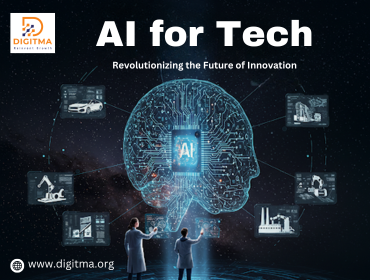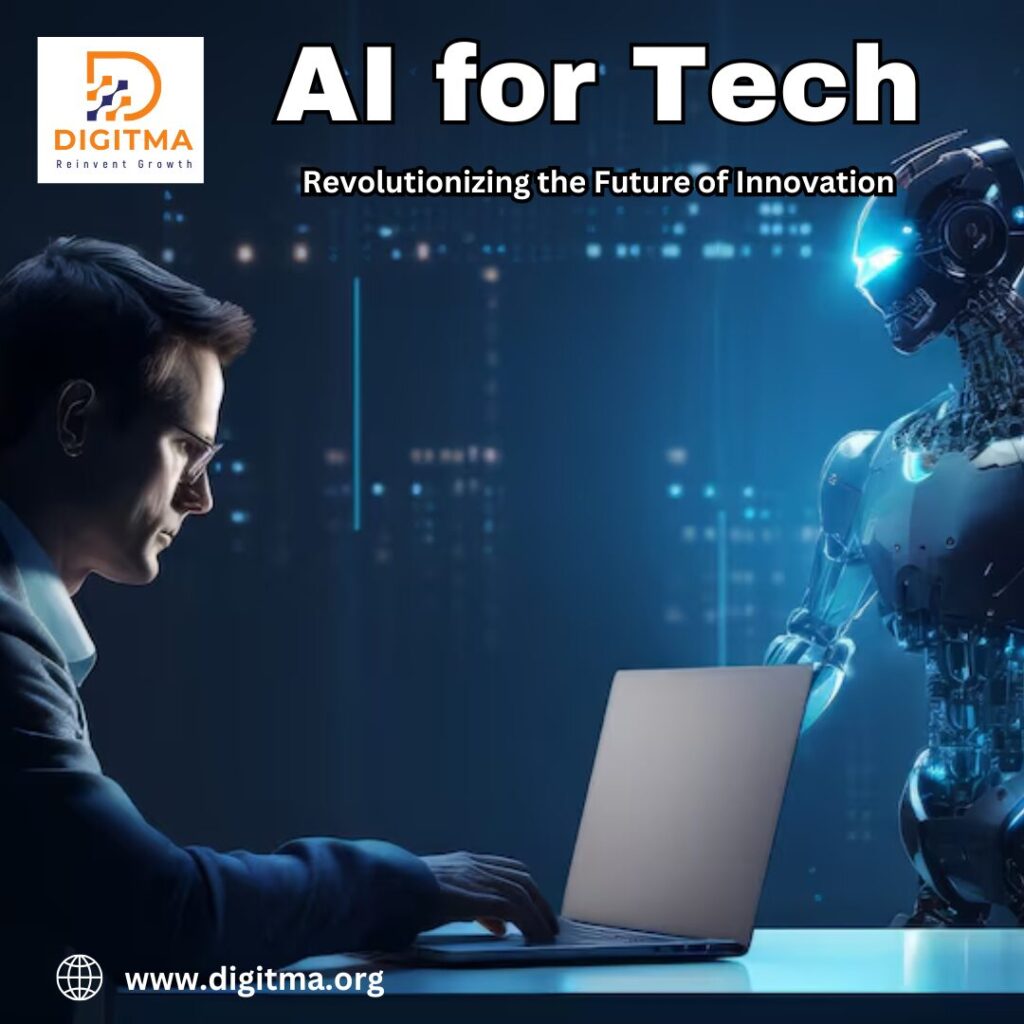
AI for Tech: Revolutionizing the Future of Innovation
Artificial Intelligence, AI for Tech, is one of the fastest-growing and most exciting technologies today. But what exactly does AI mean? Simply put, it allows machines or computer programs to handle tasks that usually need human intelligence. These tasks include learning from data, recognizing patterns, solving problems, understanding language, and even making decisions.
AI is everywhere, often in ways we don’t even realize. When you ask your smartphone a question, receive personalized recommendations on streaming platforms, or see targeted ads while browsing, AI is working in the background. Businesses use it to improve customer experiences, doctors rely on it to diagnose diseases, and self-driving cars operate because of it.
In the tech industry, AI is a game-changer. It makes software smarter, speeds up repetitive tasks, and helps companies analyze large amounts of data quickly and accurately. Machine learning, natural language processing, and computer vision all fall under AI. These technologies help computers learn from data, understand human language, and interpret images or videos.
As AI continues to evolve, it creates endless opportunities for innovation. It strengthens cybersecurity, advances robotics, and reshapes industries. Whether you’re a student, a tech professional, or simply curious about technology, understanding AI is becoming more important than ever.
In this blog, we’ll cover AI’s for tech basics, how it works, real-world applications, and why it plays a key role in modern technology. Stay tuned to see how AI is transforming the digital world.

Cracking the Code: How Does AI Really Work?
AI isn’t about robots taking over the world; it’s about teaching machines to think—or at least mimic thinking. At its core, AI works like an artist with a blank canvas, using data as paint to create complex, dynamic masterpieces. Here’s how the magic happens:
1. The Brain Behind the Bot: Machine Learning (ML)
Think of teaching a dog new tricks—the more you practice, the better it gets. Machine Learning works the same way. This AI subset allows algorithms to learn from data and improve over time. Every time Spotify curates the perfect playlist, ML is at work, analyzing your preferences, spotting patterns, and fine-tuning recommendations.
2. When Machines Speak Human: Natural Language Processing (NLP)
Ever wondered how Siri understands your mumbled morning commands? That’s NLP. It enables machines to comprehend, interpret, and even respond in human language. Whether chatbots assist customers or translation apps break language barriers, NLP strengthens communication between humans and machines.
3. Eyes for the Digital World: Computer Vision
If AI had eyes, Computer Vision would power them. This technology helps machines interpret and understand visual data—whether recognizing faces in photos, spotting defects in manufacturing, or enabling self-driving cars to “see” the road ahead.
4. Thinking in Layers: Neural Networks
Inspired by the human brain, neural networks help AI recognize patterns and make decisions. Picture a vast web of interconnected nodes (like neurons) that process information in layers. This deep learning approach drives facial recognition, medical diagnostics, and countless other AI advancements.
How AI Integrates with Technology
AI doesn’t work alone—it thrives alongside other technologies. Here’s how AI connects with different tech fields:
- Data Processing: AI depends on vast amounts of data. Big data platforms collect, store, and process this information, helping AI learn and make decisions.
- Cloud Computing: Platforms like Google Cloud, AWS, and Microsoft Azure provide the infrastructure AI needs to store data and run complex algorithms without relying on physical hardware.
- Internet of Things (IoT): Smart devices, like wearables and home gadgets, generate real-time data. AI processes this data to make smart decisions, such as adjusting your thermostat based on your habits.
- Robotics: AI allows robots to complete tasks autonomously. In factories, AI-powered robots assemble products with extreme precision.
- Natural Language Processing (NLP): AI enables voice assistants like Siri and Alexa to understand and respond to human speech, making everyday interactions smoother and more intuitive.
How Technology Supports AI
Just as AI enhances technology, technology also plays a crucial role in supporting AI. Let’s explore some key ways technology helps AI function efficiently:
- Advanced Hardware: High-performance processors, such as GPUs (Graphics Processing Units), speed up AI computations. Companies like NVIDIA lead the way in developing these powerful processors.
- Software Development: AI applications rely on programming languages like Python, R, and TensorFlow, which allow developers to build intelligent systems.
- 5G Networks: Faster internet speeds enable real-time AI applications, such as self-driving cars and augmented reality (AR) experiences.
- Cybersecurity: Since AI systems handle vast amounts of data, technology ensures their security by protecting them from cyber threats.
How Companies Use AI
AI is not just a futuristic concept—it is already transforming industries. Let’s look at how major companies like Google, Tesla, and NVIDIA use AI to drive innovation.
1. Google: AI at the Core of Everything
Google is one of the most AI-driven companies in the world. Here’s how AI powers its products and services:
- Search Algorithms: Whenever you type a query into Google, AI instantly analyzes the words, understands the intent, and delivers the most relevant results.
- Google Translate: AI allows Google Translate to understand and convert languages with impressive accuracy, making global communication seamless.
- Google Maps: By analyzing traffic data, road conditions, and user reports, AI provides the fastest routes and estimated travel times.
- YouTube Recommendations: AI tracks your watching habits, identifies patterns, and suggests videos you’ll likely enjoy.
- Google Assistant: This virtual assistant understands voice commands, answers questions, sets reminders, and even controls smart devices—all thanks to AI.
2. Tesla: Revolutionizing Transportation with AI
Tesla has redefined the automobile industry with its AI-powered electric vehicles. Here’s how AI enhances Tesla’s cars:
- Autopilot: AI processes data from cameras, sensors, and GPS to make real-time driving decisions.
- Full Self-Driving (FSD): Tesla is developing AI systems that will allow cars to navigate traffic, change lanes, and park—without human intervention.
- Battery Management: AI optimizes battery performance by analyzing driving patterns, ultimately extending battery life.
- Voice Commands: AI enables Tesla drivers to control various features with voice commands, making driving more convenient and safe.
3. NVIDIA: Powering AI with Cutting-Edge Technology
While NVIDIA is best known for its graphics cards, it is also a major force in AI development. Here’s how AI fuels its innovations:
- GPUs for AI: NVIDIA designs high-performance GPUs that accelerate AI computations, benefiting industries from gaming to scientific research.
- AI in Healthcare: AI-powered tools assist in medical imaging, drug discovery, and disease prediction, improving healthcare outcomes.
- Autonomous Vehicles: NVIDIA provides AI platforms that help self-driving cars process data from cameras and sensors to navigate safely.
- AI Research: NVIDIA continues to invest in AI research, developing new algorithms for robotics, finance, and entertainment.
Other Companies Using AI
Many other global companies integrate AI into their operations:
- Amazon: Uses AI for product recommendations, Alexa’s voice assistant, and warehouse logistics.
- Apple: Powers Face ID, Siri, and personalized content recommendations.
- Microsoft: Enhances Office tools, Azure cloud services, and virtual assistants with AI.
The Benefits of AI in Technology
AI is revolutionizing technology in several ways. Here’s why it’s making such a big impact:
- Efficiency: AI automates repetitive tasks, allowing businesses and individuals to save time.
- Accuracy: AI minimizes human errors, particularly in data analysis and medical diagnostics.
- Cost Savings: By automating tasks, AI helps companies reduce labor costs and improve productivity.
- Personalization: AI customizes user experiences, such as personalized shopping recommendations.
- Innovation: AI drives breakthroughs in space exploration, renewable energy, and smart cities.
Challenges of AI Integration
Despite its many advantages, AI also comes with challenges. Let’s take a look at some of the key issues:
- Data Privacy: AI relies on large datasets, which raises concerns about data security and user privacy.
- Job Displacement: Automation can replace certain jobs, making it essential for workers to develop new skills.
- Bias in AI: Since AI learns from data, it can sometimes inherit biases, leading to unfair outcomes.
- Complexity: Building and maintaining AI systems requires specialized knowledge, making it difficult for smaller businesses to implement AI.
The Future of AI and Technology
AI is evolving rapidly, and the future looks promising. Here are some key trends to watch:
- AI in Everyday Devices: AI will become a standard feature in smart home gadgets, wearable
- health monitors, and even household appliances.
- AI in Education: Personalized learning powered by AI will help students learn at their own pace, making education more accessible.
- AI and Augmented Reality (AR): AI will enhance AR applications for gaming, virtual shopping, and remote work experiences.
- Ethical AI: As AI becomes more powerful, companies will focus on building fair, transparent, and unbiased AI systems.
What’s Next? The Future of AI in Tech
AI isn’t just evolving—it’s accelerating at an unprecedented pace. Imagine a world where your fridge knows exactly when to restock groceries, cars drive without human intervention, and virtual tutors customize lessons to fit each student’s unique learning style. We are moving toward a future where AI doesn’t just enhance technology—it becomes the foundation of it.
AI + IoT: Smarter, More Connected Homes
AI and the Internet of Things (IoT) will work together to create even smarter homes. Devices will communicate seamlessly, allowing your thermostat, lights, and security system to adjust automatically based on your habits. Everyday tasks will become more intuitive, making life easier and more efficient.
Quantum Leap: AI Meets Quantum Computing
The combination of AI and quantum computing will unlock possibilities beyond our imagination. Quantum computers process information at lightning speed, enabling AI to solve complex problems that traditional computers cannot handle. This advancement could revolutionize industries like healthcare, climate science, and cybersecurity.
Ethical AI: Building a Fair and Transparent Future
As AI becomes more powerful, ethical concerns grow. Transparency, fairness, and accountability will be essential to ensure AI makes unbiased decisions and respects user privacy. Companies and governments will need to establish guidelines to create responsible AI systems that benefit everyone.
Conclusion
Artificial Intelligence is transforming the world at an incredible pace. It has moved beyond science fiction and into our everyday lives, making technology smarter and more efficient. Companies like Google, Tesla, and NVIDIA are leading this change by using AI to improve search engines, power self-driving cars, and accelerate computing. Other major players like Amazon, Apple, and Microsoft also rely on AI to enhance customer experiences, streamline operations, and strengthen security.
AI’s integration with cloud computing, IoT, and 5G networks has opened endless possibilities, from personalized recommendations to smart home automation. However, challenges such as data privacy, job displacement, and ethical concerns must be addressed to ensure responsible AI development.
Looking ahead, AI for tech will continue shaping industries like healthcare, education, and renewable energy. It’s not just a technological tool—it’s a driving force behind innovation, helping us build a smarter, more connected world.


